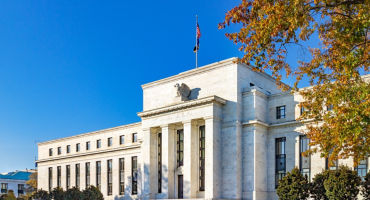- Macro Strategist
Skip to main content
- Funds
- Capabilities
- Insights
- About Us
Asset classes
Singapore, Individual
Changechevron_rightThe views expressed are those of the authors at the time of writing. Other teams may hold different views and make different investment decisions. The value of your investment may become worth more or less than at the time of original investment. While any third-party data used is considered reliable, its accuracy is not guaranteed.
My initial assessment of the sweeping tariffs the US presidential administration announced on 2 April is that they appear to be genuinely groundbreaking with potentially far-reaching consequences for financial risk assets, but I want to start by emphasising again how much could change. The extent of the US trading partners’ countermeasures — at time of writing, China has already announced a 34% tariff on all US imports — and the US administration’s tolerance levels for negative blowback in particular could alter the trajectory over the near and longer term. However, what we know is that the outlook is bad for growth, from both a US and global perspective, and markets have reacted accordingly. We see a clear risk-off move, with equities going down and bond rallying. However, what is interesting is that the US dollar is not benefiting from its traditional safe-haven status and rather than rallying, as you would expect, it is doing the opposite by falling against most currencies.
This could be a tentative sign that global investors may be reconsidering how they view the US. After all, why are so many of the world’s assets parked there? In my view, it is because the world’s largest economy offered growth, return and liquidity but also safety and credibility. Tariffs don't only hit growth in the short term; they also change how international investors think about what the US has to offer. How the US Federal Reserve (Fed) responds could be a critical part of this changing investor perception. I think that tariffs are putting the Fed in a difficult position. The growth shock may put pressure on policymakers to cut rates aggressively but that may raise demand and, with it, the impact of tariffs on prices, which would push up inflation.
From a global investor’s perspective, this would imply that the US no longer offers the same protection against rising inflation. If the Fed keeps rates elevated to combat above-target inflation, it will face increased political pressure that could undermine its credibility, which again is a negative for investors. If investors conclude the US is henceforth likely to offer less growth, less return and less safety, we could see a structural reversal of capital flows to the detriment of the US, which would also translate into a significantly lower dollar and a higher risk premium. Much could change — it is not inconceivable, for instance, that President Trump could end up unwinding many of these tariffs — but at the same time, it is hard to negate the sense of rupture. In my opinion, there is a real possibility that we may have witnessed the shotgun start for capital flowing out of the US.
The market reaction to date also suggests a historic shift in its perception of Europe and the euro area, in particular. Hitherto, in the event of a global shock, Europe always tended to be the weak spot, with recurring doubts about credit sustainability forcing the euro area into fiscal tightening. To date, we have not seen a repeat of that scenario. Instead, what we're seeing is a stronger euro and tight sovereign spreads. Investors appear to view Europe in a fundamentally different light since Germany agreed to a structural fiscal loosening. This means that Europe may finally be able to reposition policy pre-emptively and adopt a more pro-growth stance. I think this is an important development for investors to watch, especially if it were to coincide with a return of European investors’ capital from the US.
Expert

Sacrificing stocks on the altar of trade
Continue readingBy
Early thoughts on historic hike in US tariffs
Continue readingWhat do tariffs mean for portfolios?
Continue readingOh baby, baby, it’s a wild world
Continue readingFinding fixed income opportunity in unprecedented times
Continue readingAllocating to fixed income in an age of austerity
Continue readingMaking the most of the new economic era’s bright spots
Continue readingURL References
Related Insights

FOMC meeting: Misery loves company
Fixed Income Portfolio Manager Jeremy Forster explores the Fed's decision to hold rates, downgraded economic forecasts, and the implications of balance-sheet policy changes on inflation and market conditions.

The US equity rotation: Where have all the good vibes gone?
After riding into 2025 on a wave of post-election euphoria, the US stock market has struggled to find its footing so far this year. Global Investment and Multi-Asset Strategist Nanette Abuhoff Jacobson looks at what’s changed in the markets and what it might mean for investors.

Chart in Focus: Can quality hedge against inflation?
Can Quality hedge against inflation? In this latest edition of Chart in Focus, we explore the historic outperformance of high-quality stocks and bonds during periods of high inflation, perhaps offering lessons should inflation surprise to the upside in 2025.
Multiple authors

Sacrificing stocks on the altar of trade
Brij Khurana discusses the Trump administration's new stance on trade and its impact on the US economy, global markets and asset prices.
By

Early thoughts on historic hike in US tariffs
Macro Strategist Michael Medeiros explores the significant economic and market implications of the latest US tariffs, highlighting potential recession and inflation spikes, and the impact on global trade relations.

What do tariffs mean for portfolios?
Tariffs exceeded market expectations. Now what? Expect short-term volatility, identify concentrations and consider using sell-offs as an entry point to diversify across regions and styles, says Nanette Abuhoff Jacobson, Global Investment and Multi-Asset Strategist.

Oh baby, baby, it’s a wild world
Just one quarter into the year, many policy and economic assumptions have been turned on their head. What does it all mean for equity, bond, and commodity markets around the world? Members of our Investment Strategy & Solutions Group offer their outlook.

Finding fixed income opportunity in unprecedented times
Brian Garvey and Brij Khurana highlight the importance of diversified fixed income portfolios in managing volatility and seizing opportunities amid economic uncertainty.

Allocating to fixed income in an age of austerity
Amar Reganti and Adam Norman explore how flexible fixed income strategies may offer stability and yield in a volatile market environment.

Making the most of the new economic era’s bright spots
Despite uncertainty, there are important factors that justify a more optimistic approach. By focusing on structural trends and considering a wide range of views, investors can position portfolios for positive long-term returns.

FOMC meeting: Misery loves company
Fixed Income Portfolio Manager Jeremy Forster explores the Fed's decision to hold rates, downgraded economic forecasts, and the implications of balance-sheet policy changes on inflation and market conditions.

The US equity rotation: Where have all the good vibes gone?
After riding into 2025 on a wave of post-election euphoria, the US stock market has struggled to find its footing so far this year. Global Investment and Multi-Asset Strategist Nanette Abuhoff Jacobson looks at what’s changed in the markets and what it might mean for investors.

Chart in Focus: Can quality hedge against inflation?
Can Quality hedge against inflation? In this latest edition of Chart in Focus, we explore the historic outperformance of high-quality stocks and bonds during periods of high inflation, perhaps offering lessons should inflation surprise to the upside in 2025.
Multiple authors

Sacrificing stocks on the altar of trade
Brij Khurana discusses the Trump administration's new stance on trade and its impact on the US economy, global markets and asset prices.
By

Early thoughts on historic hike in US tariffs
Macro Strategist Michael Medeiros explores the significant economic and market implications of the latest US tariffs, highlighting potential recession and inflation spikes, and the impact on global trade relations.

What do tariffs mean for portfolios?
Tariffs exceeded market expectations. Now what? Expect short-term volatility, identify concentrations and consider using sell-offs as an entry point to diversify across regions and styles, says Nanette Abuhoff Jacobson, Global Investment and Multi-Asset Strategist.

Oh baby, baby, it’s a wild world
Just one quarter into the year, many policy and economic assumptions have been turned on their head. What does it all mean for equity, bond, and commodity markets around the world? Members of our Investment Strategy & Solutions Group offer their outlook.

Finding fixed income opportunity in unprecedented times
Brian Garvey and Brij Khurana highlight the importance of diversified fixed income portfolios in managing volatility and seizing opportunities amid economic uncertainty.

Allocating to fixed income in an age of austerity
Amar Reganti and Adam Norman explore how flexible fixed income strategies may offer stability and yield in a volatile market environment.

Making the most of the new economic era’s bright spots
Despite uncertainty, there are important factors that justify a more optimistic approach. By focusing on structural trends and considering a wide range of views, investors can position portfolios for positive long-term returns.

Monthly Market Review — February 2025
A monthly update on equity, fixed income, currency, and commodity markets.

FOMC meeting: Misery loves company
Fixed Income Portfolio Manager Jeremy Forster explores the Fed's decision to hold rates, downgraded economic forecasts, and the implications of balance-sheet policy changes on inflation and market conditions.

The US equity rotation: Where have all the good vibes gone?
After riding into 2025 on a wave of post-election euphoria, the US stock market has struggled to find its footing so far this year. Global Investment and Multi-Asset Strategist Nanette Abuhoff Jacobson looks at what’s changed in the markets and what it might mean for investors.

Chart in Focus: Can quality hedge against inflation?
Can Quality hedge against inflation? In this latest edition of Chart in Focus, we explore the historic outperformance of high-quality stocks and bonds during periods of high inflation, perhaps offering lessons should inflation surprise to the upside in 2025.
Multiple authors
URL References
Related Insights
Past results are not necessarily indicative of future results and an investment can lose value. Funds returns are shown net of fees. Source: Wellington Management
© 2024 Morningstar, Inc. All Rights Reserved. The information contained herein: (1) is proprietary to Morningstar; (2) may not be copied or distributed; and (3) is not warranted to be accurate, complete or timely. Neither Morningstar nor its content providers are responsible for any damages or losses arising from any use of this information. The Overall Morningstar Rating for a fund is derived from a weighted average of the three, five, and ten year (if applicable) ratings, based on risk-adjusted return. Past performance is no guarantee of future results.
The content within this page is issued by Wellington Management Singapore Pte Ltd (UEN: 201415544E) (WMS). This advertisement or publication has not been reviewed by the Monetary Authority of Singapore. Information contained on this website is provided for information purposes and does not constitute financial advice or recommendation in any security including but not limited to, share in the funds and is prepared without regard to the specific objectives, financial situation or needs of any particular person.
Investment in the funds described on this website carries a substantial degree of risk and places an investor’s capital at risk. The price and value of investments is not guaranteed. The value of the shares of the funds and the income accruing to them, if any, and may fall or rise. An investor may not get back the original amount invested and an investor may lose all of their investment. Investment in the funds described on this website is not suitable for all investors. Investors should read the prospectus and the Product Highlights Sheet of the respective fund and seek financial advice before deciding whether to purchase shares in any fund. Past performance or any economic trends or forecast, are not necessarily indicative of future performance. Some of the funds described on this website may use or invest in financial derivative instruments for portfolio management and hedging purposes. Investments in the funds are subject to investment risks, including the possible loss of the principal amount invested. None of the funds listed on this website guarantees distributions and distributions may fluctuate and may be paid out of capital. Past distributions are not necessarily indicative of future trends, which may be lower. Please note that payment of distributions out of capital effectively amounts to a return or withdrawal of the principal amount invested or of net capital gains attributable to that principal amount. Actual distribution of income, net capital gains and/or capital will be at the manager’s absolute discretion. Payments on dividends may result in a reduction of NAV per share of the funds. The preceding paragraph is only applicable if the fund intends to pay dividends/ distributions. Performance with preliminary charge (sales charge) is calculated on a NAV to NAV basis, net of 5% preliminary charge (initial sales charge). Unless stated otherwise data is as at previous month end.
Subscriptions may only be made on the basis of the latest prospectus and Product Highlights Sheet, and they can be obtained from WMS or fund distributors upon request.
This material may not be reproduced or distributed, in whole or in part, without the express written consent of Wellington Management.
We seek to exceed the investment objectives and service expectations of our fund investors and their advisers worldwide
© Copyright 2025 Wellington Management Singapore Pte. Ltd. All rights reserved.
WELLINGTON MANAGEMENT FUNDS ® is a registered service mark of Wellington Group Holdings LLP.
Wellington Management Singapore Pte. Ltd., a private limited company incorporated in the Republic of Singapore. Address: 8 Marina Boulevard, Tower 1 #03-01 Marina Bay Financial Centre 018981. Licensed and regulated by the Monetary Authority of Singapore.
Monthly Market Review — February 2025
A monthly update on equity, fixed income, currency, and commodity markets.
By
Brett Hinds
Jameson Dunn